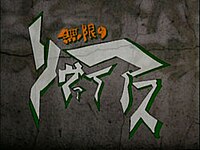| Infinite Ryvius | |
 Infinite Ryvius anime series logo | |
| 無限のリヴァイアス (Mugen no Ryvius) | |
|---|---|
| Genre | Science fiction, psychodrama |
| Anime television series | |
| Directed by | Gorō Taniguchi |
| Written by | Yōsuke Kuroda |
| Music by | Katsuhisa Hattori M.I.D. |
| Studio | Sunrise |
| Licensed by | |
| Original network | TV Tokyo |
| Original run | October 6, 1999 – March 23, 2000 |
| Episodes | 26 |
| Manga | |
| Written by | Yōsuke Kuroda |
| Illustrated by | Shinsuke Kurihashi |
| Published by | MediaWorks |
| English publisher | ComicsOne (volume 1) DrMaster (volume 2) |
| Magazine | Monthly Comic Dengeki Daioh |
| Demographic | Shōnen |
| Original run | December 18, 1999 – September 18, 2000 |
| Volumes | 2 |
| Original net animation | |
| Infinite Ryvius: Illusion | |
| Studio | Sunrise |
| Released | June 30, 2000 |
| Runtime | 5–7 minutes |
| Episodes | 6 |
Infinite Ryvius (Japanese: 無限のリヴァイアス, Hepburn: Mugen no Rivaiasu) is a 26-episode science fiction drama series produced by Sunrise.
The character and mecha designs in Ryvius were created by Hisashi Hirai, who later went on to act as the character designer for Gundam SEED.
The series is also noted for its music, which blends western R&B/hip-hop with J-pop vocals, including its title song "dis–", performed by bilingual Japanese-American singer Mika Arisaka. Most of the songs were composed by M.I.D., while background instrumentals were created by Katsuhisa Hattori.
The anime was originally licensed by Bandai Entertainment in North America until it went out of print in 2012. Following the 2012 closure of Bandai Entertainment, Sunrise announced at Otakon 2013 that Sentai Filmworks had rescued Infinite Ryvius, along with a handful of other former BEI titles.[1]
A two-volume manga adaptation was released concurrently with the series in 1999–2000, which was then published in English in 2004. A parody spin-off original net animation (ONA) series Infinite Ryvius: Illusion, was released in 2000.[2]
- ^ "Sentai Filmworks Adds Sacred Seven, The Big O, Kurokami, More". Anime News Network. Retrieved 11 August 2013.
- ^ "リヴァイアスイリュージョン その". Infinite Ryvius (Official Site) (in Japanese). TV Tokyo. Retrieved 19 December 2019.